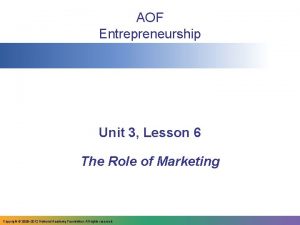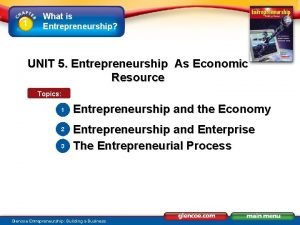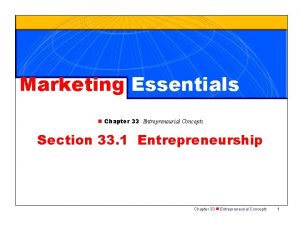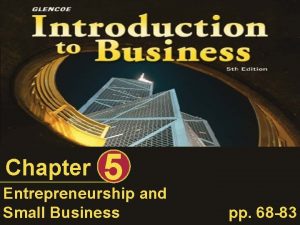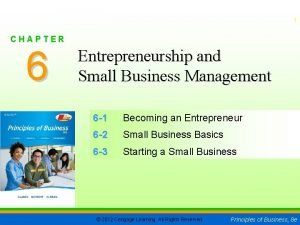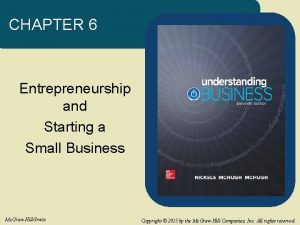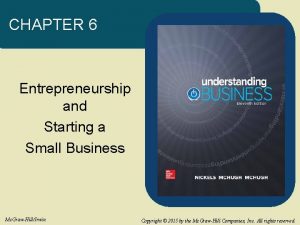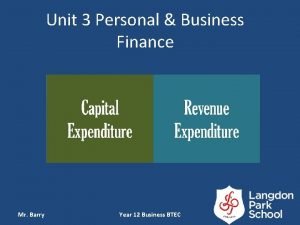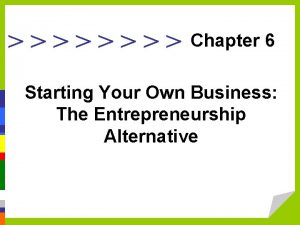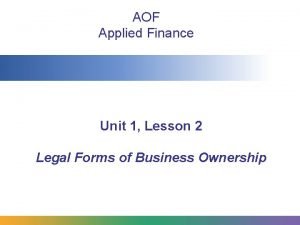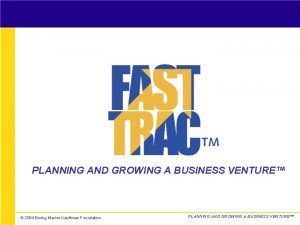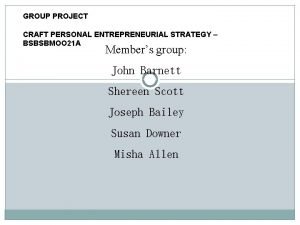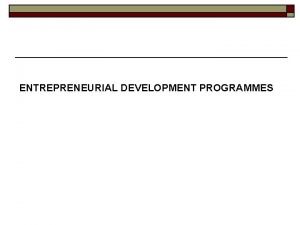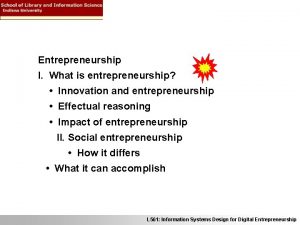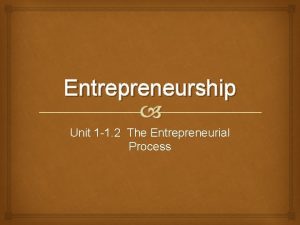Unit 11 Entrepreneurship and Finance Chapter 33 Entrepreneurial





















































- Slides: 53

Unit 11 Entrepreneurship and Finance Chapter 33 Entrepreneurial Concepts Chapter 34 Risk Management Chapter 35 Developing a Business Plan Chapter 36 Financing the Business

Chapter 33 Entrepreneurship Entrepreneurial Concepts • Section 33. 1 Entrepreneurship • Section 33. 2 Logistics of Business Ownership

Entrepreneurship Key Terms entrepreneurship entrepreneurs Objectives Define entrepreneurship Detail the advantages of entrepreneurship Explain the risks and disadvantages of entrepreneurship List the characteristics and skills of entrepreneurs Understand the importance of small business in the U. S. and global economies Marketing Essentials Chapter 33, Section 33. 1

Entrepreneurship Study Organizer Draw a diagram like this one and list the characteristics of entrepreneurship as you review this section. Marketing Essentials Chapter 33, Section 33. 1

What Is Entrepreneurship? entrepreneurship The process of starting and operating your own business. Entrepreneurship. X is the process of starting and operating your own business. Marketing Essentials Chapter 33, Section 33. 1

What Is Entrepreneurship? entrepreneurs People who create, launch, organize, and manage a new business and take the risk of business ownership. Entrepreneurs. X are people who create, launch, organize, and manage a new business and take the risk of business ownership. Entrepreneurs often have an idea, or business concept, that drives their business. Combining this vision with the means to manufacture the product (or provide the service) and market it can make huge contributions to the economy. Marketing Essentials Chapter 33, Section 33. 1

Advantages of Entrepreneurship The advantages of entrepreneurship can include: • Personal freedom • Personal satisfaction • Increased self-esteem • Increased income Marketing Essentials Chapter 33, Section 33. 1

Disadvantages of Entrepreneurship Entrepreneurial disadvantages include: • High level of stress • Possible setbacks • Risk of failure • Potential loss of income • Long and irregular hours • The need to handle multiple tasks • Strong self-discipline Marketing Essentials Chapter 33, Section 33. 1

Disadvantages of Entrepreneurship Starting a new business requires a major commitment of: • Time • Money • Effort The risk of failure with a new business is very real. Only two-thirds of new businesses survive at least two years, and only about half survive at least four years. Failure also means loss of employment. Marketing Essentials Chapter 33, Section 33. 1

Entrepreneurship as a Career Choice First, entrepreneurs must have the skills necessary to run their business, such as: • Determination • Self-motivation • Self-confidence • Strong organizational skills • Leadership ability • Self-discipline Marketing Essentials Chapter 33, Section 33. 1

Entrepreneurship as a Career Choice • Creativity • Willingness to work hard • Spirit of adventure • Good social skills Marketing Essentials Chapter 33, Section 33. 1

Entrepreneurship as a Career Choice If you want to start a business, you should assess your personal qualities, abilities, interests, and skills to see if you have the characteristics of a successful entrepreneur. Doing research on the type of business you want to start is essential. Asking family members, friends, and other businesspeople who are in the same or a similar business about their experiences is a good start. Marketing Essentials Chapter 33, Section 33. 1

Entrepreneurship as a Career Choice Entrepreneurs with a good understanding of marketing have an advantage over those who do not. Many resources exist for entrepreneurs who need help with marketing. Marketing Essentials Chapter 33, Section 33. 1

The Role of Entrepreneurship in the Domestic and Global Economy Entrepreneurs and small to medium businesses play a key role in the domestic and the global economies: They generate growth at a rate that is much faster than other larger and more established businesses. According to the Global Entrepreneurship Monitor (GEM), firms with fewer than 500 employees were responsible for 50 percent of the United States GDP. Marketing Essentials Chapter 33, Section 33. 1

Entrepreneurship and the Global Economy New businesses are a sign of an economy’s vitality and readiness to find or invent new opportunities in a world market that has become more and more challenging. The U. S. Small Business Administration (SBA) is finding new ways to help small businesses in the global economy, such as providing loans, training, and information. Marketing Essentials Chapter 33, Section 33. 1

Trends in Entrepreneurship Several recent trends in the marketplace have fostered the growth of entrepreneurship: • The availability of technology • Increased global communication • The rise of the Internet and e-commerce • A society and a market that are more and more diversified Marketing Essentials Chapter 33, Section 33. 1

SECTION 33. 1 REVIEW

SECTION 33. 1 REVIEW - click twice to continue -

Key Terms franchise sole proprietorship unlimited liability partnership general partnership limited partnership corporation stockholders limited liability foreign corporation limited liability company (LLC) Doing Business As (DBA) Articles of Incorporation Logistics of Business Ownership Objectives Identify the forms of business ownership Name the legal steps to take in establishing a business Marketing Essentials Chapter 33, Section 33. 2

Logistics of Business Ownership Study Organizer Think of yourself as an entrepreneur and write down the steps you need to take to establish your new business in a chart like this one. Marketing Essentials Chapter 33, Section 33. 2

Business Ownership Opportunities There are four ways to enter business: • Purchase an existing nonfranchise business • Take over the family business • Start a new business • Purchase a franchise business Marketing Essentials Chapter 33, Section 33. 2

Purchase an Existing Nonfranchise Business The prospective buyer must investigate the reasons for the sale of the business, as well as consider the business’s local reputation. The buyer is completely responsible for the business after the purchase, so every aspect should be examined before the deal is closed. Marketing Essentials Chapter 33, Section 33. 2

Take Over the Family Business The new owner must explore potential conflicts and concerns with family members. Succession planning (transition to the next generation), managing growth, and family relations are some of the challenges of taking over and running a family business. Marketing Essentials Chapter 33, Section 33. 2

Start a New Business Starting a new business gives an entrepreneur great freedom of choice. While the decisions to be made are completely under his/her control, it is also the new owner’s responsibility to establish a reputation and build a customer base. Marketing Essentials Chapter 33, Section 33. 2

Purchase a Franchise Business franchise A legal agreement to sell a parent company’s product or services in a designated geographic area. A franchise. X is a legal agreement to sell a parent company’s product or services in a designated geographic area. The franchisee (person buying the business) has to invest money to buy the franchise and also pays an annual fee and a share of the profits. In return, the franchisor provides a well-known name, business plan, advertising, and the proven methods and products of the parent company. This strategy has a high initial cost. Marketing Essentials Chapter 33, Section 33. 2

Forms of Business Organization unlimited liability A business owner’s financial liability is not limited to investments in the business, but extends to his or her total ability to make payments. There are four possible forms of business organization: • Sole proprietorship • Partnership • Corporation • Limited liability company (LLC) One of the disadvantages of a sole proprietorship is unlimited liability. X. This means a business owner’s financial liability is not limited to investments in the business, but extends to his or her total ability to make payments. Marketing Essentials Chapter 33, Section 33. 2

Sole Proprietorship sole proprietorship A business owned and operated by one person. A sole proprietorship X is a business owned and operated by one person. While the profits are greater in this system, business debts and legal judgments against the company are the responsibility of the owner. Marketing Essentials Chapter 33, Section 33. 2

The Partnership partnership A legal agreement between two or more people to be jointly responsible for the success or failure of a business. A partnership. X is a legal agreement between two or more people to be jointly responsible for the success or failure of a business. Marketing Essentials Chapter 33, Section 33. 2

The Partnership general partnership A way to organize a business in which each partner shares in the profits and losses. In a general partnership X, each partner shares in the profits and losses, with each one’s share of the profits taxed as personal income. Each partner has unlimited liability for the company’s debts. Marketing Essentials Chapter 33, Section 33. 2

The Partnership limited partnership A form of business organization in which each limited partner is liable for any debts only up to the amount of his/her investment in the company. The business’s general partner is liable for all debts. In a limited partnership X, each limited partner is liable for any debts only up to the amount of his or her investment in the company. Every limited partnership must have at least one general partner who has unlimited liability. Marketing Essentials Chapter 33, Section 33. 2

The Partnership A partnership may make more capital available, allowing easier operation and expansion, and it is taxed solely on the profits of the business. However, even when owners do not agree on business decisions, the actions of one are still legally binding on the others. All partners must assume their share of the business debt. The business is also dissolved if one partner dies. It can be reorganized, but the process is time consuming and costly. Marketing Essentials Chapter 33, Section 33. 2

The Corporation corporation A legal entity created by either a state or a federal statute authorizing individuals to operate an enterprise. A corporation. X is a legal entity created by either a state or a federal statute authorizing individuals to operate an enterprise. It has several unique features: • Legal permission to operate stockholders • Separate legal entity The owners of a corporation with limited liability. • Stockholders. X–the owners of a corporation • Board of directors Marketing Essentials Chapter 33, Section 33. 2

The Corporation limited liability The personal assets of the owners cannot be taken if the company does not meet its financial obligations. Corporations offer limited liability. X–personal assets of the owners cannot be taken if the company does not meet its financial obligations or gets into legal trouble. Marketing Essentials Chapter 33, Section 33. 2

The Corporation There are two main categories of corporations: private and public. A public corporation is a business entity created by the federal, state, or local government. This group can include incorporated cities as well as school, transit, and sanitation districts. Marketing Essentials Chapter 33, Section 33. 2

The Corporation A private corporation is formed by private persons. This category is very broad. It includes closely held corporations, which are owned by a few persons or a family. It also includes publicly held corporations, which are companies whose stock is owned by large numbers of people. Marketing Essentials Chapter 33, Section 33. 2

The Corporation foreign corporation A company that is incorporated under the laws of a state that differs from the one in which it does business. Forming a corporation is a complicated process. An entrepreneur must determine: • The company’s internal corporate structure • The processes for selecting a board of directors and electing officers • The state in which to establish the company A foreign corporation X is one that is incorporated under the laws of a state that differs from the one in which it does business. Marketing Essentials Chapter 33, Section 33. 2

The Corporation There are four main advantages of incorporation: • Each owner has limited liability • It is easier to raise capital (money) • Owners can easily enter or exit the business by buying or selling stock • Management is shared Marketing Essentials Chapter 33, Section 33. 2

The Corporation Disadvantages include: • Complexity of formation • Increased government regulation • Corporate profits are taxed • Intricate accounting and record keeping Marketing Essentials Chapter 33, Section 33. 2

The Limited Liability Company limited liability company (LLC) A relatively new form of business organization that is a hybrid of a partnership and corporation. The limited liability company (LLC) X is a hybrid of a partnership and a corporation. Its owners are shielded from personal liability, and all profits and losses pass directly to the owners without taxation of the entity itself. Marketing Essentials Chapter 33, Section 33. 2

Legal Steps to Establishing a Business Before an entrepreneur can start a new business, he or she must take specific steps to legally establish and protect the business. These steps vary depending on whether the business will be a sole proprietorship, partnership, corporation, or limited liability company. Marketing Essentials Chapter 33, Section 33. 2

Step 1: Find Help The entrepreneur might wish to consult with an accountant, attorney, or other business advisor. When a corporation is formed, many states require that an attorney be hired to guide the entrepreneur through the complicated steps of incorporation. Marketing Essentials Chapter 33, Section 33. 2

Step 2: Register the Business DBA (Doing Business As) The registration by which a county government officially recognizes that a new proprietorship or partnership exists. A DBA (Doing Business As) X is the registration by which the county government officially recognizes that a new proprietorship or partnership exists. Marketing Essentials Chapter 33, Section 33. 2

Step 2: Register the Business Articles of Incorporation A document filed with a state department of commerce that identifies the name and address of a new corporation, its purpose, the names of the initial directors, and the amount of stock that will be issued to each director. To form a corporation, an entrepreneur must file Articles of Incorporation X with the corporation and securities bureau in the state’s department of commerce. The articles of incorporation identify the new company’s: • Name and address • Purpose • Names of the initial directors • Amount of stock that will be issued to each director Marketing Essentials Chapter 33, Section 33. 2

Step 2: Register the Business To form an LLC requires filing Articles of Organization with the state. Many states also require LLCs to have an operating agreement. Marketing Essentials Chapter 33, Section 33. 2

Obtain Licenses establish minimum standards of education and training for people who practice in particular professions. Companies may also have to get local licenses or permits to comply with zoning ordinances, building codes, and safety standards. Marketing Essentials Chapter 33, Section 33. 2

SECTION 33. 2 REVIEW

SECTION 33. 2 REVIEW - click twice to continue -

Section 33. 1 Being an entrepreneur involves risk taking, but it can bring both personal and financial rewards. Advantages of entrepreneurship include being your own boss and earning a high income if the business succeeds. Entrepreneurs can try out their own ideas, set their own work schedules, and make their own business decisions. Disadvantages of entrepreneurship include the risk of failure, long working hours, and the potential loss of income. continued

Section 33. 1 Entrepreneurship is important to our economy. It creates jobs, which provide income to individuals and communities. continued

Section 33. 2 The four ways to become a business owner are (1) purchase an existing business, (2) take over the family business, (3) start a new business, and (4) purchase a franchise business. The four forms of business organization are (1) sole proprietorship, (2) partnership, (3) corporation, and (4) limited liability company.

DECA performance indicators: • Explain the types of business ownership • Explain the concept of private enterprise • Describe legal issues affecting businesses • Explain the types of business risk • Address people properly

CHAPTER 33 REVIEW

CHAPTER 33 REVIEW - click twice to continue -
 Introduction to entrepreneurship module pdf
Introduction to entrepreneurship module pdf Economics unit 3 lesson 7
Economics unit 3 lesson 7 Economics unit 3 lesson 6
Economics unit 3 lesson 6 Unit 5 entrepreneurship and business
Unit 5 entrepreneurship and business 7 pathways
7 pathways Chapter 33 entrepreneurial concepts
Chapter 33 entrepreneurial concepts Entrepreneurship unit 3
Entrepreneurship unit 3 Entrepreneurship unit 3
Entrepreneurship unit 3 Entrepreneurship unit 2
Entrepreneurship unit 2 Entrepreneurship unit 3
Entrepreneurship unit 3 Entrepreneurship unit 3
Entrepreneurship unit 3 Background of entrepreneur example
Background of entrepreneur example Entrepreneurship chapter 6
Entrepreneurship chapter 6 Chapter 5 entrepreneurship and small business
Chapter 5 entrepreneurship and small business Chapter 5 entrepreneurship
Chapter 5 entrepreneurship Entrepreneurship and small business management chapter 6
Entrepreneurship and small business management chapter 6 Entrepreneurship chapter 6
Entrepreneurship chapter 6 Entrepreneurship chapter 1
Entrepreneurship chapter 1 Chapter 5 entrepreneurship and small business
Chapter 5 entrepreneurship and small business Chapter 6 entrepreneurship and starting a small business
Chapter 6 entrepreneurship and starting a small business Chapter 6 entrepreneurship and starting a small business
Chapter 6 entrepreneurship and starting a small business Entrepreneurship chapter 6
Entrepreneurship chapter 6 Chapter 6 entrepreneurship and small business management
Chapter 6 entrepreneurship and small business management Business unit 3 personal and business finance
Business unit 3 personal and business finance Principles of business and finance
Principles of business and finance Unit 3 personal and business finance
Unit 3 personal and business finance Unit 10, unit 10 review tests, unit 10 general test
Unit 10, unit 10 review tests, unit 10 general test Managing human resources in small and entrepreneurial firms
Managing human resources in small and entrepreneurial firms Entrepreneurial strategy and competitive dynamics
Entrepreneurial strategy and competitive dynamics Entrepreneurial behaviour and motivation
Entrepreneurial behaviour and motivation Employee selection
Employee selection Growing and internationalizing the entrepreneurial firm
Growing and internationalizing the entrepreneurial firm Managing human resources in small and entrepreneurial firms
Managing human resources in small and entrepreneurial firms Entrepreneurial mind frame heart flame and gut game meaning
Entrepreneurial mind frame heart flame and gut game meaning Entrepreneurial and intrapreneurial mind
Entrepreneurial and intrapreneurial mind Chapter 3 entrepreneurship
Chapter 3 entrepreneurship Entrepreneurship chapter
Entrepreneurship chapter Entrepreneurship chapter 4
Entrepreneurship chapter 4 Entrepreneurship chapter 6
Entrepreneurship chapter 6 Entrepreneurial grid
Entrepreneurial grid Chapter 2 entrepreneurship
Chapter 2 entrepreneurship Llc advantages and disadvantages
Llc advantages and disadvantages Unit 3 lesson 7 finance
Unit 3 lesson 7 finance Personal finance unit 1 review
Personal finance unit 1 review Unit 9 raising finance
Unit 9 raising finance Chapter 11 finances and career planning
Chapter 11 finances and career planning Unit 2 lesson 12 interest rates
Unit 2 lesson 12 interest rates Entrepreneurial skills pass
Entrepreneurial skills pass Kauffman center for entrepreneurial leadership
Kauffman center for entrepreneurial leadership Difference between entrepreneurship and intrapreneurship
Difference between entrepreneurship and intrapreneurship Strategic entrepreneurial growth
Strategic entrepreneurial growth National level of entrepreneurial mindset
National level of entrepreneurial mindset Personal entrepreneurial strategy
Personal entrepreneurial strategy Factors affecting entrepreneurship growth
Factors affecting entrepreneurship growth


